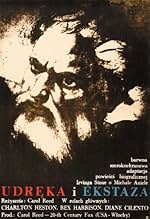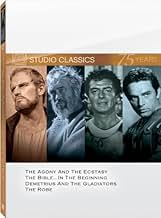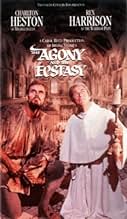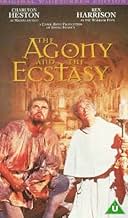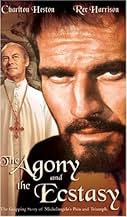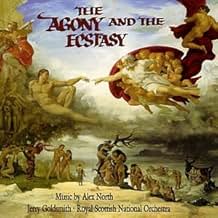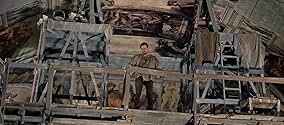CALIFICACIÓN DE IMDb
7.2/10
8.5 k
TU CALIFICACIÓN
La historia biográfica de los problemas de Miguel Ángel mientras pintaba la Capilla Sixtina a instancias del Papa Julio II.La historia biográfica de los problemas de Miguel Ángel mientras pintaba la Capilla Sixtina a instancias del Papa Julio II.La historia biográfica de los problemas de Miguel Ángel mientras pintaba la Capilla Sixtina a instancias del Papa Julio II.
- Nominado a 5 premios Óscar
- 3 premios ganados y 9 nominaciones en total
Fortunato Arena
- Pope's Bodyguard
- (sin créditos)
Lars Bloch
- Baron Von Silenen
- (sin créditos)
Angelo Boscariol
- Papal Guard
- (sin créditos)
Calisto Calisti
- Physician
- (sin créditos)
Amerigo Castrighella
- Quarry cart assistant
- (sin créditos)
Anita Ceccotti
- Woman Under the Chapel
- (sin créditos)
Enrico Chiappafreddo
- Tavern Customer
- (sin créditos)
- Dirección
- Guionistas
- Todo el elenco y el equipo
- Producción, taquilla y más en IMDbPro
Opiniones destacadas
The film is an epic grandeur feature of a interpersonal tug-of-war between the maestro Michelangelo and Pope Julius II.
I cannot help being shell-shocked to see the reconstruction of the magnificent ceiling though recognizably most of which is the trickery of montage (not in the real the Sistine Chapel, the location was inside Cinecitta Italy instead), but bathing under the glamour and solemnness of the visual wonders, I am stunned to exude my admiration and awe!
The two leads conspicuously stimulate a Moses versus Caesar confrontation, Charlton Heston seems to be more boorish than artistic to manifest a struggled Michelangelo, may God doesn't distinguish his people by their looks. The "agony and ecstasy" is watered down to an underwhelming stalemate thanks to Charlton's outlandish incarnation as the most eminent artist of that time. Rex Harrison, is by far and large worthy another Oscar nomination for his arresting devotedness, which is apt to impress the audience with a mind-blowing bi-polar characterization while good and evil coexist at the same time.
The film was a grave box office fiasco when it came out in 1965, however, judging by my appraisement, its merits still can be appreciated by our generation (a well-balanced script, the haunting original score and all the props and settings). However, the film entirely skipped Michelangelo's sexual orientation and awkwardly ploys a portentous conversation between Michelangelo and his admirer Contessina de'Medici (a over-wise Diane Cilento), which unveiled its cowardliness and helplessness.
My final remark is that as time goes by ruthlessly, art stands still and never fades away, so lucky enough cinema is yet a part of it.
I cannot help being shell-shocked to see the reconstruction of the magnificent ceiling though recognizably most of which is the trickery of montage (not in the real the Sistine Chapel, the location was inside Cinecitta Italy instead), but bathing under the glamour and solemnness of the visual wonders, I am stunned to exude my admiration and awe!
The two leads conspicuously stimulate a Moses versus Caesar confrontation, Charlton Heston seems to be more boorish than artistic to manifest a struggled Michelangelo, may God doesn't distinguish his people by their looks. The "agony and ecstasy" is watered down to an underwhelming stalemate thanks to Charlton's outlandish incarnation as the most eminent artist of that time. Rex Harrison, is by far and large worthy another Oscar nomination for his arresting devotedness, which is apt to impress the audience with a mind-blowing bi-polar characterization while good and evil coexist at the same time.
The film was a grave box office fiasco when it came out in 1965, however, judging by my appraisement, its merits still can be appreciated by our generation (a well-balanced script, the haunting original score and all the props and settings). However, the film entirely skipped Michelangelo's sexual orientation and awkwardly ploys a portentous conversation between Michelangelo and his admirer Contessina de'Medici (a over-wise Diane Cilento), which unveiled its cowardliness and helplessness.
My final remark is that as time goes by ruthlessly, art stands still and never fades away, so lucky enough cinema is yet a part of it.
When you think about it, making a movie about artistry is pretty hard. Painting, writing, sculpting, music, whatever, it's not easy to make the act very interesting--painting is painstaking, it takes a long time. But in this movie, they succeed. Not just making a movie, but making an epic, a massive movie out of an act of creation, is a tough thing to do. But they really do succeed. At the heart of the movie isn't really the act of creation, or the passion for it, or even the ceiling itself--it's the adversarial relationship between Rex Harrison (Pope Julius II) and Charlton Heston (Michaelangelo).
It's certainly not that passion and creation are not here, it's just that they enrich the story about two men and their relationship. When Julius comes into the chapel in the middle of the night, and Michaelangelo is invariably there, there's a bond, even with silent incipient tension.
Heston is of course the only person for this role, as epics go, he's the best. For some reason he manages not to be overcome by the massive scale of these sorts of movies--something that happens to almost everyone else (look at Sinatra and Cary Grant in "the Pride and the Passion", they are totally lost in the grande scale, and they're the incomparable Grant and the larger than life Sinatra, not much more to be said there). Heston makes a solid tortured artist and Rex Harrison is quite wonderful as the Pope. He communicates the strength and intelligence of a Pope who loves art but must go to battle to preserve all that he holds dear. There's a scene when the Pope wants people to see the half completed chapel, since he has grown impatient with the time and when Michaelangelo bitterly objects, Harrison explodes with anger--extremely effective. When Harrison passed, it was truly a loss to movies.
There are flaws, no question, and it's not Heston's best work, course, once you've done Ben Hur and the Ten Commandments, nothing else is going to be your best work. The subplot with the sort of love interest is pretty silly, and it goes on a bit too long. The earnestness of the faith in the church, the sincerity of Heston when he says "Holiness" to the pope, a man that drives him crazy, is poignant. His faith is deep, almost as if he derives his love of art from a love of God. There are even some nice moments of levity as when a spattered Michaelangelo spits out a gob of paint and it lands near a watching Julius; or when the Pope creates a cardinal out of teen for payment in order to keep up the painting.
When it comes to big movies, this definitely lays with a handful of others that will never be surpassed--Titanic tried to be this kind of movie, and proves that even with $200 million and all the nifty gizmos of the modern age, it's very difficult to do; c'mon, Rex Harrison and Charlton Heston compared to Leo DeCaprio and Billy Zane--not much of a contest there.
See the movie, forgive it its flaws and appreciate the richness and nuance of the relationship between Pope and Artist.
It's certainly not that passion and creation are not here, it's just that they enrich the story about two men and their relationship. When Julius comes into the chapel in the middle of the night, and Michaelangelo is invariably there, there's a bond, even with silent incipient tension.
Heston is of course the only person for this role, as epics go, he's the best. For some reason he manages not to be overcome by the massive scale of these sorts of movies--something that happens to almost everyone else (look at Sinatra and Cary Grant in "the Pride and the Passion", they are totally lost in the grande scale, and they're the incomparable Grant and the larger than life Sinatra, not much more to be said there). Heston makes a solid tortured artist and Rex Harrison is quite wonderful as the Pope. He communicates the strength and intelligence of a Pope who loves art but must go to battle to preserve all that he holds dear. There's a scene when the Pope wants people to see the half completed chapel, since he has grown impatient with the time and when Michaelangelo bitterly objects, Harrison explodes with anger--extremely effective. When Harrison passed, it was truly a loss to movies.
There are flaws, no question, and it's not Heston's best work, course, once you've done Ben Hur and the Ten Commandments, nothing else is going to be your best work. The subplot with the sort of love interest is pretty silly, and it goes on a bit too long. The earnestness of the faith in the church, the sincerity of Heston when he says "Holiness" to the pope, a man that drives him crazy, is poignant. His faith is deep, almost as if he derives his love of art from a love of God. There are even some nice moments of levity as when a spattered Michaelangelo spits out a gob of paint and it lands near a watching Julius; or when the Pope creates a cardinal out of teen for payment in order to keep up the painting.
When it comes to big movies, this definitely lays with a handful of others that will never be surpassed--Titanic tried to be this kind of movie, and proves that even with $200 million and all the nifty gizmos of the modern age, it's very difficult to do; c'mon, Rex Harrison and Charlton Heston compared to Leo DeCaprio and Billy Zane--not much of a contest there.
See the movie, forgive it its flaws and appreciate the richness and nuance of the relationship between Pope and Artist.
I like historical films. Recently I watched three historical films all made in the early 1960s. These are 'El Cid', 'The Spartacus' and 'The Agony and The Ecstasy'. Of the three, I rate The Agony and the Ecstasy as the best. This film is based on the eponymous novel written by Irving Stone. I had read the book nearly a decade back and it was nice to see the film finally. The film is about the circumstances under which Michelangelo came to compose his famous frescoes in the Sistine Chapel of Rome in the 16th century. The Sistine fresco, the 'creation of man' has become almost an emblem for the artist. But not many know that Michelangelo painted the Sistine frescoes reluctantly, only because he was forced to do so by his patron, Pope Julius II. The film is about the war of wits between these two great men Pope Julius II is a warrior pope, a worldly Pope. His concern is to protect the papal states from being over run by warring European powers. For this he is willing to take up arms. The pope knows that the posterity wont remember him for his spiritual prowess or leadership. Therefore he want to leave great works of art as his legacy. He therefore hires Michelangelo to paint the ceiling of the Sistine Chapel. The artist is not very keen on painting and considers sculpture to be his true calling. He is also not willing to conform to the prevailing canons of artistic excellence. He feels constrained by the limits of time and money that is set. All the great moments of the film occur when the Pope and the Artist clash. It is a clash of ideas and world views: (1) Whether sculpture is a superior form of art as compared to painting; (2) Whether it is appropriate depict biblical figures in their raw humanity; (3) Whether it is moral for a man of god to take arms for his principles and so on. For me the finest scene in the film is where the Pope and the Cardinals come to see the frescoes and judge it as lacking in good taste. The Artist is forced to give a strong rebuttal and in the process he expounds the humanist philosophy of art. Shot in beautiful Technicolor, the film still looks spectacular. It is a visual and intellectual treat.
I would be more generous than Maltin was with this one. I watched it again recently on tape and my impression improved over my first viewing. The production values are sumptuous, and the construction of a 1:1 mockup of the Sistine Chapel by Dino deLaurentis is a story in itself, evidently. Heston is pretty good as Michelangelo but is, I think, overshadowed by Harrison, who is just marvelous as Pope Julius (a previous commenter remarked on the historically inauthentic absence of his beard; in addition, Julius was too old & infirm too ride a horse into battle, but insisted on leading while carried on a litter). The conflicted interplay between Julius & Michelangelo is the core of the film, of course, and the script does its job well in this regard, particularly in the closing dialogue. It is interesting, though, to see how the movie dances around the issue of Michelangelo's purported homosexuality. We are so much more frank today (not necessarily for the better), and one shudders to consider how a contemporary movie would treat this subject (not that there's a chance in hell of a major movie being made today on the subject of the creation of one of the masterworks of the West's artistic inheritance). If any movie definitely needs the letterbox format to show it off at its best, it is this one, so watch for it on TMC where it is often shown that way.
like many historical films from the same age of Hollywood, the word "impressive" is the first to say. not only for its status of epic drama, costumes and the translation in image of a period. but, maybe , more important, for the admirable clash between Rex Harrison and Charlton Heston. and for the feel than a great story has its right and fair adaptation. because something impose "The Agony and the Ectasy" as special. not the biography of a great artist - and the admirable virtue is to know than Heston is Michelangelo not only act him - but the chance to discover yourself. the film, like the book, it is a beautiful eulogy to the life. using a genius as character of a kind of parable about art, proud, honesty and desire. so, just impressive. in this case - a word with deep roots.
Portrayals of the Pope On Screen
Portrayals of the Pope On Screen
Take a look at actors who have portrayed the Pope in movies and on television. And no, we're not going to spoil Conclave if you haven't watched it yet.
¿Sabías que…?
- TriviaThe book on which this movie is based covers the entire life of Michelangelo Buonarroti. This movie based on a single chapter. One of the shortest, if not the shortest, in the entire book.
- ErroresAs shown in the movie, Michelangelo created a flat wooden platform on brackets built out from holes in the wall, high up near the top of the windows. But contrary to what is depicted in the film, he did not lie on this scaffolding while he painted, but painted from a standing position.
- ConexionesEdited from Prologue: The Artist Who Did Not Want to Paint (1965)
Selecciones populares
Inicia sesión para calificar y agrega a la lista de videos para obtener recomendaciones personalizadas
- How long is The Agony and the Ecstasy?Con tecnología de Alexa
Detalles
- Fecha de lanzamiento
- País de origen
- Idiomas
- También se conoce como
- The Agony and the Ecstasy
- Locaciones de filmación
- Piazza del Popolo, Todi, Perugia, Umbria, Italia(St. Peter's Square scene)
- Productora
- Ver más créditos de la compañía en IMDbPro
Taquilla
- Presupuesto
- USD 10,000,000 (estimado)
- Tiempo de ejecución2 horas 18 minutos
- Color
- Relación de aspecto
- 2.20 : 1
Contribuir a esta página
Sugiere una edición o agrega el contenido que falta

Principales brechas de datos
What is the Japanese language plot outline for La agonía y el éxtasis (1965)?
Responda

